Plain Language and Ethical Action: A Dialogic Approach to Technical Content in the Twenty-First Century
by Russell Willerton
Interface Design: An Introduction to Visual Communication in UI Design
by Dave Wood
Genetic Counseling Research: A Practical Guide
by Ian M. MacFarlane, Patricia McCarthy Veach, and Bonnie S. LeRoy
Reclaiming Conversation: The Power of Talk in a Digital Age
by Sherry Turkle
User Experience Design: Creating Designs Users Really Love
by Gavin Allanwood and Peter Beare
Part of Our Lives: A People’s History of the American Public Library
by Wayne A. Wiegand
Facilitator’s and Trainer’s Toolkit: Engage and Energize Participants for Success in Meetings, Classes, and Workshops
by Artie Mahal
The UX Five-Second Rules: Guidelines for User Experience Design’s Simplest Testing Technique
by Paul Doncaster
Reading Sounds: Closed-Captioned Media and Popular Culture
by Sean Zdenek
Assuring Quality in Online Education: Practices and Processes at the Teaching, Resource, and Program Levels
by Kay Shattuck, ed.
Smaller, Faster, Lighter, Denser, Cheaper: How Innovation Keeps Proving the Catastrophists Wrong
by Robert Bryce
How Posters Work
by Ellen Lupton, Caitlin Condell, and Gail Davidson
Advertising Design and Typography
by Alex W. White
Project Leadership: Creating Value with an Adaptive Project Organization
by Barry L. Cross and M. Kathryn Brohman
WordPress: The Missing Manual
by Matthew MacDonald
The Power of Visual Storytelling: How to Use Visuals, Videos, and Social Media to Market Your Brand
by Ekaterina Walter and Jessica Gioglio
Out of the Box Thinking for Successful Managers
by William F. Roth
Applying Educational Research: How to Read, Do, and Use Research to Solve Problems of Practice, 7th ed.
by M. D. Gall, Joyce P. Gall, and Walter R. Borg
Intelligent Content: A Primer
by Ann Rockley, Charles Cooper, and Scott Abel
Infographic Designers’ Sketchbooks
by Steven Heller and Rick Landers
Digital Cosmopolitans: Why We Think the Internet Connects Us, Why It Doesn’t, and How to Rewire It
by Ethan Zuckerman
Teaching and Learning with Technology
by Judy Lever-Duffy and Jean McDonald
Training Design Basics, 2nd ed.
by Saul Carliner
Landmark Essays on Speech and Writing
by Peter Elbow, ed.
Information Age: Six Networks that Changed the World
by Tilly Blyth, ed.
Plain Language and Ethical Action: A Dialogic Approach to Technical Content in the Twenty-First Century
Russell Willerton. 2015. New York, NY: Routledge. [ISBN 978-0-415-74104-0. 202 pages, including index. US$44.95 (softcover).]
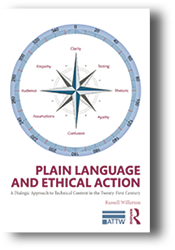 Plain language allows the reader to understand the writer’s intended meaning upon a first reading. The criteria of readability and comprehensibility do not make plain language inherently ethical, however, for content plainly described may also be of dubious morality. Yet plain language, with its emphasis on describing things in a way the audience is most likely to understand, does “support ethical action” through the “benefits it can provide in specific contexts” (p. 175). Imagine the opposite situation: jargon-like or bureaucratic language so obscure that it misleads the reader. Plain language, in contrast, demands clarity and precision, and in that sense implies an ethical obligation to the reader.
Plain language allows the reader to understand the writer’s intended meaning upon a first reading. The criteria of readability and comprehensibility do not make plain language inherently ethical, however, for content plainly described may also be of dubious morality. Yet plain language, with its emphasis on describing things in a way the audience is most likely to understand, does “support ethical action” through the “benefits it can provide in specific contexts” (p. 175). Imagine the opposite situation: jargon-like or bureaucratic language so obscure that it misleads the reader. Plain language, in contrast, demands clarity and precision, and in that sense implies an ethical obligation to the reader.
In Plain Language and Ethical Action: A Dialogic Approach to Technical Content in the Twenty-First Century, Willerton identifies a framework for diagnosing the need for plain language: BUROC, or Bureaucratic, Unfamiliar, Rights Oriented, and Critical. BUROC occurs when processes are described in great detail with little recourse to audience context (Bureaucracy); the language is rife with Unfamiliar terms; the audience’s ability to act within their Rights is compromised by linguistic confusion; and the situation is or becomes Critical.
To avoid BUROC, the writer must understand the audience through Martin Buber’s dialogic distinction between I–It—treating the other person as a means, an object, or tool—and I–Thou—treating the other person as an end, as a complex, unique individual. The I–Thou relationship occurs in what Buber calls a “narrow ridge” or “place between two sides of an argument where the parties can meet if they regard each other as Thou and not It” (p.43).
BUROC erodes the I–Thou relationship between writer and reader by not accounting for the actual situation in which the reader finds himself, as in a bureaucracy that reduces individuals to mindless functions within a system. Plain language, by insisting on the I–Thou relationship as a prerequisite for communication, sets up the basis for and prompts ethical action. Knowing that the audience needs understanding within a particular context, we are morally compelled to write in terms of that specificity and uniqueness.
Understanding the audience thoroughly is therefore the primal requirement for ethical, plain language communication and can be achieved by involving users and readers as co-creators from the beginning of the writing process. The I–Thou relationship emerges through a collaborative, ongoing feedback process that requires “strong practices for writing and reviewing” (p. 178), such as milestone checkpoints, clearly defined roles and responsibilities, and testing the product on an as-you-go basis.
For plain language proponents, then, the fundamental ethical tenet is that the communicator must understand, respect, and write to the audience’s specific, unique needs and not assume what the audience is like. Thanks to its practicality, Willerton’s method can be immediately integrated with the technical writing process, empowering writers and users to work together in producing technically accurate and ethically sound documents.
Donald R. Riccomini
Donald R. Riccomini is a member of STC and a lecturer in English at Santa Clara University, where he specializes in teaching engineering and technical communications. He previously spent twenty-three years in high technology as a technical writer, engineer, and manager in semiconductors, instrumentation, and server development.
Interface Design: An Introduction to Visual Communication in UI Design
Dave Wood. 2014. London, England: Bloomsbury Publishing. [ISBN 978-2-9404-1199-3. 192 pages, including index. US$41.95 (softcover).]
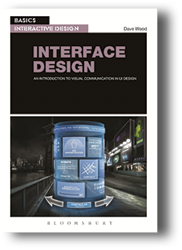 Interface Design: An Introduction to Visual Communication in UI Design introduces the basic principles of user interface (UI) design: user experience (UX), information architecture, and graphic design. Wood’s approach contains a few principles that can be applied to development team members, including technical writers, but its primary audience is graphic designers.
Interface Design: An Introduction to Visual Communication in UI Design introduces the basic principles of user interface (UI) design: user experience (UX), information architecture, and graphic design. Wood’s approach contains a few principles that can be applied to development team members, including technical writers, but its primary audience is graphic designers.
Wood opens with a chapter on basic user-centered design and the role of a graphic designer within a development team. Chapter 2 introduces information architecture structures that can be applied across different interface types (websites and video games, for example) and emphasizes iterative planning and testing to refine the information architecture. Chapters 3 and 4 delve specifically into visual communication using elements such as color, layout, and typography, and how to transmit messages and branding via those elements. Chapter 5 provides advice for working within a development team, including designing visual elements modularly so they are easier for a programmer to implement across the interface and a range of platforms. The final chapter closes with the implications of emerging technologies on the future of graphic design.
The chapters are divided into short, digestible segments with accompanying illustrations and plenty of whitespace, making the book a quick read. Each chapter ends with an interview with a practitioner whose expertise relates to the current discussion and a case study that showcases the chapter’s advice using a real-world example. This structure, for the most part, works well, and the case studies are one of Interface Design’s strongest features. At times, there is an excess of illustrations in the chapters: Some images add nothing important while a few even contradict the principles under discussion.
Another weakness in Wood’s book is that the breadth prohibits depth into any single subject. It is impossible to cover every interface development aspect in a single, short volume. However, the author’s intended audience is graphic designers, and he succeeds in detailing practical advice for that audience, especially in the book’s central chapters.
Some of Wood’s advice applies to anyone involved in developing an interface. He emphasizes focusing on your users’ goals and organizing the information architecture around them from the beginning as well as refining the structure and layout throughout the process using wireframes (diagrams of the basic layout), paper prototyping, and iterative usability testing. Another key tip is “designing for modularity,” or recognizing patterns of content (buttons, logos, background images) that are reused throughout the interface (p. 140). Breaking the design down into repeatable elements makes coding the interface easier and optimizes cross-platform display.
Although Interface Design has something to offer any development team member, it speaks best to a graphic designer because of its detailed recommendations and processes. I would recommend it to anyone who wants a general introduction to other development process aspects (such as UX and information architecture) and more detailed advice from a graphic design perspective.
Bonnie J. Shamp Winstel
Bonnie J. Shamp Winstel is a technical writer for a small software company in Huntsville, Alabama. She received her master’s degree in English and Technical Communication at the University of Alabama in Huntsville in May 2013 and is a New TC Professional member of STC.
Genetic Counseling Research: A Practical Guide
Ian M. MacFarlane, Patricia McCarthy Veach, and Bonnie S. LeRoy. 2014. New York, NY: Oxford University Press. [ISBN 978-0-19-935909-7. 290 pages, including index. US$47.95 (softcover).]
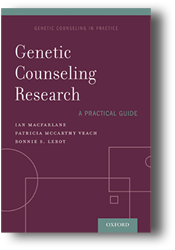 Genetic Counseling Research: A Practical Guide is intended as a guide for genetic counselors and genetic counseling students pursuing research in their field. It outlines the entire research process starting with formulating research questions and progressing through preparing a manuscript for publication. Accompanying many chapters are useful worksheets to help the reader through each step. Appropriate research tools and resources are also referred to along the way.
Genetic Counseling Research: A Practical Guide is intended as a guide for genetic counselors and genetic counseling students pursuing research in their field. It outlines the entire research process starting with formulating research questions and progressing through preparing a manuscript for publication. Accompanying many chapters are useful worksheets to help the reader through each step. Appropriate research tools and resources are also referred to along the way.
The first chapter lists seven criteria for good research questions and is supplemented by a Research Idea Log in the Appendix. Completion of a literature review follows the development of research questions. Tips are presented for finding sources with suggestions on what to do when too many or too few sources are found and advice is given on critiquing research literature for both qualitative and quantitative studies. The Ethics in Research chapter covers research integrity, the process of obtaining consent from Institutional Review Boards, plagiarism, and conflicts of interest. Choosing a paradigm is another important aspect of the research process. The authors explain both quantitative and qualitative methods and point out benefits and drawbacks of both. An overview of various sampling methods is also outlined.
The meatiest part of Genetic Counseling Research contains chapters on designing quantitative research studies and analyzing the resulting data. Particularly helpful are a Decision Making Flowchart (pp. 171–172), definitions of common statistical terms, and explanations of various statistical methods. The chapter on conducting qualitative studies discusses the philosophical underpinnings and responses to criticisms of this method. Finally, the authors lay out the process of preparing a manuscript for publication. The last chapter provides guidelines for directing research, either as a research advisor in a graduate training program or as a genetic counselor acting as a research team leader.
Genetic Counseling Research excels at defining terms and clearly explaining concepts. Another strength is that the authors do a great job of warning against common pitfalls and mistakes in research, potentially saving novice researchers in particular from major problems. Coverage of the research process is very comprehensive. I would consider it to be an indispensable resource for both genetic counselors and students wishing to embark on genetic counseling research projects.
Jennifer Spanier
Jennifer Spanier has been a freelance book and database indexer since 2009 and is an active member of the American Society for Indexing. Previously, she has worked as a biologist and a public librarian and indexes in a wide variety of subject areas.
Reclaiming Conversation: The Power of Talk in a Digital Age
Sherry Turkle. 2015. New York, NY: Penguin Press. [ISBN: 978-1-59420-555-2. 436 pages, including index. US$27.95.]
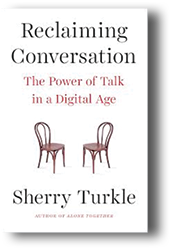 Sherry Turkle is a sociologist and a licensed clinical psychologist at Massachusetts Institute of Technology (MIT), so when she discusses technology, she knows what she is talking about. Author of several books on the effects of technology on society, she speaks with authority and deep insight.
Sherry Turkle is a sociologist and a licensed clinical psychologist at Massachusetts Institute of Technology (MIT), so when she discusses technology, she knows what she is talking about. Author of several books on the effects of technology on society, she speaks with authority and deep insight.
What concerns her most in Reclaiming Conversation: The Power of Talk in a Digital Age is the effect technology is having on our ability to empathize, which Turkle considers a key element that makes us human. She is not anti-technology but rather pro-conversation. Turkle thinks we must be more intentional about how we use technology and we must understand what we are losing when we abuse it, particularly with the use of smartphones.
Her book is a compilation of research based on data and conversations with students with insights of memoir tantalizingly scattered here and there. For example, Turkle learned the importance of privacy from her grandmother, who said that her mailbox and library record could never be violated.
But she worries now from so many conversations with students that the smartphone has become a “tiny god” that has robbed us of our solitude, so that people must always be “plugged in” to be “turned on.” The smartphone and other technologies have damaged our ability to have face-to-face conversations, and that has endangered the ability to empathize and therefore form friendships. And finally, it is hurting our mentoring of others so that society ultimately suffers from the loss of knowledge that is not passed on.
Turkle also has interesting things to say about punctuation that would amuse technical communicators who have been laboring over these issues for years. Punctuation is crucial in texting, where texts are often read as angry unless they are softened with emoticons and punctuation—lots of punctuation. “In texting, we’ve seen that punctuation is one of the main ways to express all of the information that tone of voice and body posture would convey in a face-to-face conversation” (p. 200).
Turkle’s audiences for Reclaiming Conversation are two-fold: one that needs to be persuaded that we have lost something and another that feels defeated but still needs to be in the conversation game. I belong to the second group, as I watch zombied young workers walk down my company’s hallways without even looking up from their smartphones and young people who don’t know how to introduce themselves at a meeting (or think that they even should). I’m very concerned that the first group will not be persuaded.
Only when technical communicators like ourselves start questioning the overreach of technology will millennials see that something is wrong. I hope others will read this crucially important book and join the fight to regain what has been lost.
Charles R. Crawley
Charles R. Crawley is a lead technical writer at Rockwell Collins and an adjunct professor at Mount Mercy University in Cedar Rapids, Iowa. He texts badly but is glad to have a conversation.
User Experience Design: Creating Designs Users Really Love
Gavin Allanwood and Peter Beare. 2014. New York, NY: Fairchild Books. [ISBN: 978-2-9404-9613-6. 184 pages, including index. US. $44.95 (softcover).]
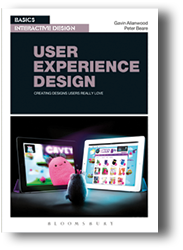 User Experience Design: Creating Designs Users Really Love is part of the Basics Interactive Design series that lets readers learn more about effective designs revolving around users. Allanwood and Beare state in the introduction that the book is for those who are learning about interactive design and plan to be involved in creating a product or service for other people to use. Part One introduces readers to a brief rundown of what user experience design (UXD) is and the many roles that take place within the field. The first chapter helps readers think about user experience and then progresses readers to understanding users, concluding in the final three chapters with challenging readers to recognize and apply UXD methods.
User Experience Design: Creating Designs Users Really Love is part of the Basics Interactive Design series that lets readers learn more about effective designs revolving around users. Allanwood and Beare state in the introduction that the book is for those who are learning about interactive design and plan to be involved in creating a product or service for other people to use. Part One introduces readers to a brief rundown of what user experience design (UXD) is and the many roles that take place within the field. The first chapter helps readers think about user experience and then progresses readers to understanding users, concluding in the final three chapters with challenging readers to recognize and apply UXD methods.
The book has many activities for readers to perform that lets them see things such as a working with a development cycle, observing a user’s journey, exploring solutions, and building a prototype. These activities give readers a chance to experience what UXD is like and how to perform it. User Experience Design concludes with design methods that discuss design patterns, layout, type, images, and toolsets to complete the projects. The book’s conclusion states that “Experiences are more important than the products or services themselves, and this has to be considered if we are going to add value to the world with our creative efforts” (p. 170).
The book leaves readers with further resources as well as a glossary to easily access new sources and terms while reading it. When working on a project, the activities, glossary, and further sources let first-time user experience designers further invest in learning more about the field and design processes.
I enjoy how Allanwood and Beare provide case studies, interviews, and activities, giving the readers a real hands-on experience in discovering how things are done within the UXD world. With these activities, readers can actually do their own user test and build their own prototype. Throughout User Experience Design, users can also complete each step just as designers would during their own design process. This book has an easy-to-read layout that can be quickly scanned to find the sections that you need. Readers can depend on the simplicity in style and the use of images to make it an easy read. User Experience Design is packed with information that will help readers learn more about designs and includes examples from real world brands.
Kristi Wiley
Kristi Wiley is currently a PhD student in Rhetoric and Writing at Michigan State University. She focuses her research on UX, content strategy, technical writing and editing, usability, and Information Architecture.
Part of Our Lives: A People’s History of the American Public Library
Wayne A. Wiegand. 2015. New York, NY: Oxford University Press. [ISBN: 978-0-19-024800-0. 332 pages, including index. US$34.95.]
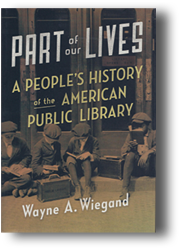 Public libraries continue to be highly regarded by Americans, even as esteem for other public institutions wanes. In Part of Our Lives: A People’s History of the American Public Library, Wayne Wiegand, Florida State University professor emeritus of library and information sciences, traces the history of this public institution and explores why libraries have “multiplied, survived, and regularly prospered” (p. 265).
Public libraries continue to be highly regarded by Americans, even as esteem for other public institutions wanes. In Part of Our Lives: A People’s History of the American Public Library, Wayne Wiegand, Florida State University professor emeritus of library and information sciences, traces the history of this public institution and explores why libraries have “multiplied, survived, and regularly prospered” (p. 265).
Wiegand found in his extensive research that Americans love libraries for more than the books they provide. Part of Our Lives is divided into chapters devoted to time periods, such as the Great Depression through World War II. As his book progresses from the colonial era of subscription-only social libraries through the first municipal library established in Boston in 1854 to the present-day wired facilities, Wiegand provides myriad examples of the library’s threefold function in the community. This public institution makes useful information accessible, offers stories that influence readers’ lives, and provides public spaces where people of different cultures, genders, races, and ages congregate for many purposes. It is this combination that gives libraries their staying power and, in Wiegand’s opinion, actually helps mold communities.
While he set out to write a history from the library patron’s point of view—to “feature . . . the voices of generations of public library users” (p. 3)—Part of Our Lives is also a record of the development of the librarian as a professional knowledge worker. The juxtaposition of patron demands with the professional standards of the librarian, which were often dramatically different, provides one of the book’s ongoing themes.
Another theme is the role of technology. From the public card catalog and book-card-in-a-pocket checkout system to today’s computers that “support most of the public library’s basic routines” (p. 250), Wiegand follows changes in library operations that include taking advantage of the very electronic media some predicted would end library usefulness.
Part of Our Lives is densely packed with facts of library history, with only a few illustrations, which could have made for tedious reading. But the many anecdotes of library users—many from original sources, such as memoirs—add a liveliness to the text that makes it very readable. While Wiegand does not provide a bibliography, his sources are well documented in his notes in each chapter.
As a fan of both libraries and history, I recommend Part of Our Lives, not only for its survey of library history, but also for its look at what was happening in American society. What happened in libraries reflected social movements, such as racial integration, trends in censorship, and women’s and gay rights, as well as the political and economic milieu library patrons were experiencing. Other readers may be as surprised as I was to discover just how integral the public library has become to American life.
Linda Davis
Linda M. Davis is an independent communications practitioner in the Los Angeles area. She holds an MA in Communication Management and has specialized in strategic communication planning, publication management, writing, and editing for more than 25 years.
Facilitator’s and Trainer’s Toolkit: Engage and Energize Participants for Success in Meetings, Classes, and Workshops
Artie Mahal. 2014. Basking Ridge, NJ: Technics Publications, LLC. [ISBN: 978-1-935504-89-4, 314 pages, including index. US$29.95 (softcover).]
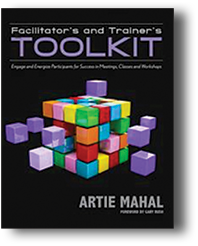 Artie Mahal’s Facilitator’s and Trainer’s Toolkit: Engage and Energize Participants for Success in Meetings, Classes, and Workshops is mostly geared toward facilitators. The author defines a trainer as “a person who teaches,” which “impl[ies] that the trainer possesses the knowledge and ‘owns’ the learning” (p. 189). Facilitators, on the other hand, “create an environment where learning can take place” (p. 189). Since I had just completed a two-week training assignment when I read this book, I found the emphasis on facilitation somewhat disappointing. However, a trainer often also acts as a facilitator, at least during the question-and-answer period of a presentation.
Artie Mahal’s Facilitator’s and Trainer’s Toolkit: Engage and Energize Participants for Success in Meetings, Classes, and Workshops is mostly geared toward facilitators. The author defines a trainer as “a person who teaches,” which “impl[ies] that the trainer possesses the knowledge and ‘owns’ the learning” (p. 189). Facilitators, on the other hand, “create an environment where learning can take place” (p. 189). Since I had just completed a two-week training assignment when I read this book, I found the emphasis on facilitation somewhat disappointing. However, a trainer often also acts as a facilitator, at least during the question-and-answer period of a presentation.
The book provides a variety of checklists and templates designed for freelance facilitators. These range from capturing the basics of a given assignment through preparation for the actual workshop or group session all the way to a follow-up assessment after the event. A discussion of various techniques that can be used to engage the audience, manage group dynamics, and elicit creative responses concludes the book.
Most of these checklists come from Mahal’s own work as an external facilitator and consultant. As the book title implies, much of the text is focused on practical advice. A few sections, however, also discuss more theoretical concepts, such as adult learning theory. The entire first chapter is also devoted to the “Mahal Facilitation Framework” developed by the author.
Originally from India, Mahal is keenly aware of the intercultural dimensions of group work in many companies and organizations and often points out potential pitfalls and limitations. For example, he notes, “of course, the dress code mentioned here is for Western cultures” (p. 113). As a translator who is also originally from elsewhere, I found this emphasis quite refreshing. In addition, an entire chapter by Catherine Mercer Bing is devoted to cross-cultural facilitation.
Facilitator’s and Trainer’s Toolkit is the first edition published by a small U.S. press. If there were a second edition, it would benefit greatly from more thorough editing and proofreading.
Barbara Jungwirth
After writing software documentation and managing an IT department, Barbara Jungwirth now translates German technical documents into polished English appropriate for a specific audience. She owns reliable translations llc (www.reliable-translations.com), writes a blog called On Language and Translation (www.reliable-translations.com/blog/), and tweets (@reliabletran). You can also connect with her on LinkedIn (www.linkedin.com/in/BarbaraJungwirth).
The UX Five-Second Rules: Guidelines for User Experience Design’s Simplest Testing Technique
Paul Doncaster. 2014. Waltham, MA: Morgan Kaufmann. [ISBN 978-0-12-800534-7. 117 pages. US$24.95 (softcover).]
 The UX Five-Second Rules: Guidelines for User Experience Design’s Simplest Testing Technique takes on a timely user experience (UX) topic: remote, unmoderated usability testing. Borne from a business environment where bottom lines often necessitate lean approaches to complex design problems, remote, unmoderated usability tests have been developed to take advantage of social media technologies and the pervasiveness of the data they make available. Users now freely post terabytes of information about their habits, needs, and desires online through many applications. Smart UX researchers are attempting to leverage these social habits to create simple, affordable approaches and tools that ask users to help solve design problems.
The UX Five-Second Rules: Guidelines for User Experience Design’s Simplest Testing Technique takes on a timely user experience (UX) topic: remote, unmoderated usability testing. Borne from a business environment where bottom lines often necessitate lean approaches to complex design problems, remote, unmoderated usability tests have been developed to take advantage of social media technologies and the pervasiveness of the data they make available. Users now freely post terabytes of information about their habits, needs, and desires online through many applications. Smart UX researchers are attempting to leverage these social habits to create simple, affordable approaches and tools that ask users to help solve design problems.
The five-second test introduced in Doncaster’s book aims to contribute a sound methodology for one specific element of remote testing: surveys that are typically tagged onto the beginning or end of tests. The author says, “A test participant is given a set of instructions, views an image of a design for a few seconds, and answers questions about it” (p. 2). Such a simple description belies a fairly elegant and rigorous approach, however, to designing these surveys. Reading The UX Five-Second Rules teaches you everything you need to know about how to design a sound user survey, including how to design sound questions, how to ensure images being tested are accessible, how to properly order survey questions to maximize response rates, and more.
Doncaster correctly asserts that user surveys, a feature included in every remote testing software application this reviewer has used (that is, UserZoom, TryMyUI, UserTesting, etc.), are often considered an add-on feature to usability tests themselves. This has rendered useless a potentially powerful tool for gaining insights into user behaviors. Part of the problem, as Doncaster points out, is that these surveys are often used when a different method might produce better results. He goes on to explain that five-second tests are only suited to very simple response situations where the user can judge in five seconds whether a design element is having its intended effect on the user. A classic example is showing a user a company logo and asking him or her to judge the logo for emotional resonance, credibility, and trustworthiness.
In an economical 108 pages, Doncaster presents some important considerations for UX researchers wishing to employ user surveys. Rather than provide an overview of the entire UX process, The UX Five-Second Rules zeroes in on one specific method and provides timely, useful advice. This book is part of a growing literature showcasing the benefits and drawbacks of specific UX methods that will hopefully encourage practitioners and researchers to refine, and ultimately systematize, their approaches to studying user behavior.
Guiseppe Getto
Guiseppe Getto is a North Carolina college professor. He is also President and Co-Founder of Content Garden, Inc., a digital marketing and UX consulting firm.
Reading Sounds: Closed-Captioned Media and Popular Culture
Sean Zdenek. 2015. Chicago, IL: University of Chicago Press. [ISBN 978-0-226-31278-1. 338 pages, including index. US$40.00 (softcover).]
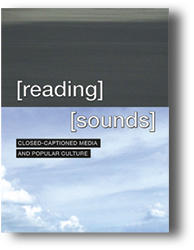 Reading Sounds: Closed-Captioned Captioned Media and Popular Culture solidifies Zdenek’s position of more than 10 years’ experience researching and writing about captions. Brenda Brueggemann gives the best review possible on the book’s dust jacket: “There’s no book like this; plain and simple, it is one of the most original new books I’ve ever read.” This review addresses several factors that help make this book so powerful.
Reading Sounds: Closed-Captioned Captioned Media and Popular Culture solidifies Zdenek’s position of more than 10 years’ experience researching and writing about captions. Brenda Brueggemann gives the best review possible on the book’s dust jacket: “There’s no book like this; plain and simple, it is one of the most original new books I’ve ever read.” This review addresses several factors that help make this book so powerful.
Reading Sounds is clearly written and enjoyable. Commanding attention from sentence one, Zdenek builds a compelling argument not just that captions are interesting but also that captioners engage in significant rhetorical work—work that impacts D/deaf, hard-of-hearing, and hearing viewers’ lived experiences. He shares more than his findings with the readers; Zdenek is transparent with his research tools and methodology. Consistent reference to his process and framework motivates with positive impact, urging readers to watch more captioned media critically. He does not focus just on “caption fails”—an easy target for new and experienced caption critics. Zdenek moves readers to watch for captioning excellence, to identify when and how captioners successfully provide full, rich access to meaning held in the soundtracks and non-speech information.
Zdenek maps out multiple research paths, topics, and potentials. This framing is potentially as important to caption studies as Blakeslee and Spilka’s (2004) “The State of Research in Technical Communication” and Blakeslee’s (2009) “The Technical Communication Research Landscape” are to technical communication research. Unlike Blakeslee and Spilka, Zdenek does not have a large community of technical communication scholars and researchers to draw from. Caption studies is currently comprised of a handful of practitioners—at least within the humanities-related portions of the field. Fortunately, as Zdenek makes clear throughout Reading Sounds, we can learn much by collaborating with captioning practitioners, researchers, and advocates.
Zdenek empowers caption research early on by presenting four basic principles and seven transformations of meaning that take place in captioning. This gifting of resources is just one example of why Reading Sounds is comparable to a Bag of Holding from Dungeons & Dragons for anyone moderately or passionately interested in captioning research. Like a Bag of Holding, this book contains far more than its 338 pages belie. Two other gems are:
a 21-page bibliography that is a goldmine for anyone interested in captioning-related work and research, and
a playful, fun, and critical analysis and discussion of diverse approaches to captioning Futurama’s Hypnotoad as well as their possible implications and meanings. This analysis also models how a close and detailed examination of popular culture can be engaging and informative.
The book’s companion site, ReadingSounds.net, has over 500 labeled, organized, and succinct captioning examples aligned with each chapter of the book. Even if Reading Sounds was not a book, this site would be worthy of close reading and review. Read the book, visit the site, and permanently change how you understand closed captioning.
Gregory Zobel
Gregory Zobel is an assistant professor of Educational Technology at Western Oregon University.
Assuring Quality in Online Education: Practices and Processes at the Teaching, Resource, and Program Levels
Kay Shattuck, ed. 2014. Sterling, VA: Stylus Publishing. [ISBN 978-1-57922-871-2. 290 pages, including index. US$35. (softcover).]
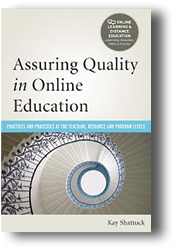 Shattuck’s edited collection offers three perspectives on assuring quality on the teaching, resource, and program levels. The seventeen chapters, plus two chapters of closing thoughts, are authored by multiple authors and balanced equally over all three levels. This is a significant strength and weakness for the book.
Shattuck’s edited collection offers three perspectives on assuring quality on the teaching, resource, and program levels. The seventeen chapters, plus two chapters of closing thoughts, are authored by multiple authors and balanced equally over all three levels. This is a significant strength and weakness for the book.
Buyers for professional development programs, holistic program review, and academic libraries will find value in Assuring Quality in Online Education: Practices and Processes at the Teaching, Resource, and Program Levels. It collects perspectives that serve the multiple audiences and stakeholders who would participate in program review, online education training, and administration. For individual stakeholders, the book holds less value. As a working faculty and former graduate program administrator, I found the book frustrating. There was just enough material in multiple chapters of the teaching and program levels to make them interesting—but there was not enough to drive me to want the book as a whole.
Each level has multiple mediocre chapters that provide overviews or descriptions. However, solid pieces; like chapter 5 on Transparency and Quality Assurance (QA) by Morrison, Paulson, and Poulin as well as chapter 8 by Bogle, Day, Matthews, and Swan; focus on collaborative and collegial approaches to online teaching, which more than balanced these weaker fillers.
Several chapters were particularly interesting. Thompson and Kuhne provide a vital and valuable emphasis on ethics in their chapter “Ethics Matters.” Besides asking core questions like what and who matter, they spend several pages discussing the ethics around employing adjuncts.
Chapter 16, “An Adaptive Model for Calculating Contact Hours in Distance-Education Courses,” presents a model for calculating credit hours in online education, an issue of consistent interest to faculty and administrators. The authors provide a good background and an interesting model. However, after several readings, I could not shake a root problem: How did they come up with the amount of suggested time for each activity? Given the detailed emphasis on time and math to calculate the contact hours, I hoped to see more explanation and justification in the reasoning or at least suggestions in how to tease out some of the complexities. A forum question that requires a short answer versus a long response that synthesizes multiple reading sources require different amounts of time. A clearer description on this issue could have helped many online educators explain how the devil is in the details to their administrators and outside critics.
Overall, Shattuck’s book has some interesting ideas, literature reviews, and several vital concepts explored. But, at the end, you have to choose carefully what you read or you might feel like you want your time back. Fortunately, the book is clearly organized with each chapter containing multiple short sections, which may empower potential readers to review the content and assess for themselves whether they should invest in several chapters or the whole book.
Gregory Zobel
Gregory Zobel is an assistant professor of Educational Technology at Western Oregon University.
Smaller, Faster, Lighter, Denser, Cheaper: How Innovation Keeps Proving the Catastrophists Wrong
Robert Bryce. 2014. New York, NY: PublicAffairs. [ISBN-978-1-61039-205-1. 374 pages, including index. US$17.95.]
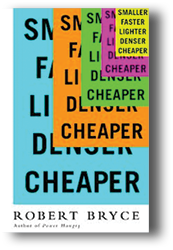 Journalist, author, and public speaker Robert Bryce has published many articles on energy and oil use and five books such as Power Hungry, The Myths of “Green” Energy, and the Real Fuels of the Future, serving as a senior member of the Manhattan Institute for Policy Research. Bryce’s latest book, Smaller, Faster, Lighter, Denser, Cheaper: How Innovation Keeps Proving the Catastrophists Wrong, provides a positive take on the future. He argues that solutions to today’s environmental challenges will come from technology. This technology will, in the future, reflect a human need to make things better, where better means faster, cheaper, lighter, denser and smaller. This includes lighter cars and faster computers.
Journalist, author, and public speaker Robert Bryce has published many articles on energy and oil use and five books such as Power Hungry, The Myths of “Green” Energy, and the Real Fuels of the Future, serving as a senior member of the Manhattan Institute for Policy Research. Bryce’s latest book, Smaller, Faster, Lighter, Denser, Cheaper: How Innovation Keeps Proving the Catastrophists Wrong, provides a positive take on the future. He argues that solutions to today’s environmental challenges will come from technology. This technology will, in the future, reflect a human need to make things better, where better means faster, cheaper, lighter, denser and smaller. This includes lighter cars and faster computers.
Reporting from locations such as California, Oklahoma, Canada, and Panama, Bryce shows how companies are providing improved products and services using newer technologies that improve our lives. Not only do they improve our lives, they are earth-friendly.
What kinds of technologies are these? Bryce mentions the printing press and mobile phones, nanotech medicine and advanced drill rigs, vacuum tubes and mass-produced fertilizer.
Which companies are involved? Bryce cites newer groups, such as Khan Academy, and established names, such as Intel and Ford, which are both start-ups and well-known companies.
The positive message appears to be focused on how we will have a better, more sustainable future as we do what humans do—make things better by making them smaller, faster, lighter, denser, and, of course, cheaper.
If you feel like the future faces social, economic, and environmental challenges, you might enjoy reading about how innovation, technology, and human drive should continue to preserve the planet and the human race.
Is the book fun to read? If you don’t mind optimism about the future, a look at innovation and human progress, comments about a future with abundant energy, lighter cars, and faster computers, you could find the book fun to read. You will also read about how people’s lives continue to improve to be more comfortable, even addressing issues of overcoming poverty. Entrepreneurs will continue to improve technologies and provide innovation, solving current problems on our planet.
Jeanette Evans
Jeanette Evans is an STC Associate Fellow and active in the NEO community, currently serving on the newsletter committee. She holds an MS in technical communication management from Mercer University. Jeanette’s published article, “Emerging Technologies: Where We Have Been and Where We Are Going,” appears in STC’s Intercom magazine.
How Posters Work
Ellen Lupton, Caitlin Condell, and Gail Davidson. 2015. New York, NY: Cooper Hewitt Smithsonian Design Museum. [ISBN 978-0-910503-82-6. 208 pages. US$29.95.]
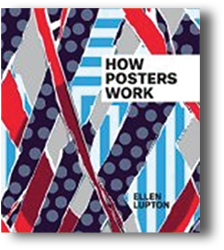 A poster’s fundamental purpose is to share information, persuade, and act as a promoter of an event or merchandise. With reference to past events, the poster has been a potent communication and propaganda tool. The poster can be traced back to the 1500s in the form of early printed broadsides. These temporary documents, lasting no more than one day (ephemera), were mass-produced on a large sheet of paper and printed on one side. The broadside delivered governmental notices and announced proclamations, events, and public decrees with the poster maker’s aim focused on utility rather than beauty. As printing processes became more advanced, broadsides also evolved, and woodblocks, copper, and metal engravings were the primary methods of producing illustrations and typography. Today’s poster did not develop and become visible as a visual communication medium until the early 19th century.
A poster’s fundamental purpose is to share information, persuade, and act as a promoter of an event or merchandise. With reference to past events, the poster has been a potent communication and propaganda tool. The poster can be traced back to the 1500s in the form of early printed broadsides. These temporary documents, lasting no more than one day (ephemera), were mass-produced on a large sheet of paper and printed on one side. The broadside delivered governmental notices and announced proclamations, events, and public decrees with the poster maker’s aim focused on utility rather than beauty. As printing processes became more advanced, broadsides also evolved, and woodblocks, copper, and metal engravings were the primary methods of producing illustrations and typography. Today’s poster did not develop and become visible as a visual communication medium until the early 19th century.
In How Posters Work, the authors analyze fourteen principles of design and perception, including their relationship to the poster as a communication medium. This book showcases a diverse collection exploring aesthetic movements, disparate expressive forms, and cultural trends to form the rich visual character of contemporary graphic design. Through the designer’s lens, the methods and practice of perception, persuasive language, and composition are employed into the physical construction of these reproduced posters. Lupton says on page 12 in her essay “Vision Is a Process”: “This is not a book about posters. It is a book about how designers see. The works assembled here show how dozens of different designers—from prominent pioneers to little-known makers—have mobilized principles of composition, perception, and rhetoric. Each poster enacts ways of thinking and making, and each poster wants to be seen. How do we look at graphic design, and how, in turn, does graphic design look back at us?”
This book is a comprehensive, diverse, contemporary collection that examines how a designer’s choices and limitations of reproduction and printing processes has dictated the making of posters as a means of visual communication. Caitlin Condell notes in her essay “How Posters Are Made,” “Most of the printing methods that are represented by the posters in these pages were invented in the service of other industries, but were adopted and transformed by enterprising designers in pursuit of their graphic vision” (p. 24).
How Posters Work is essential reading for the specialized professional, design student, or anyone interested in poster art created in the international arena, including a wealth of widely recognized images and representing celebrated posters by distinguished designers such as Erik Nitsche, Felix Pfäffli, M/M (Paris), Sulki & Min, and Paul Scher. This book is a valuable resource and noteworthy contribution to the poster’s historical development and production that continues to play a niche communications role in our present-day graphic language.
Richard B. Doubleday
Richard B. Doubleday is an assistant professor in the Department of Graphic Design at Louisiana State University’s School of Art. He is a contributing author of Phaidon Archive of Graphic Design and Meggs’ History of Graphic Design. Richard has been published in Baseline, IDEA, Print, NOVUM, Zhuangshi, and Australian Creative.
Advertising Design and Typography
Alex W. White. 2015. New York, NY: Allworth Press. [ISBN 978-1-62153-481-2. 224 pages. US$29.99 (softcover).]
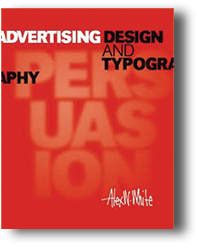 The complex nature of advertising design makes it a difficult area of study. Practitioners in this field need to be well versed in the art of persuasion as well as in how to use images, type, and space to effectively communicate with target audiences. In Advertising Design and Typography, White shares a wealth of knowledge in the advertising (ad) design field. The wisdom that White imparts about the goals of effective ad design and typography apply to all design fields. The theories that he presents on strategies and executions contain some of the best insights on the use of persuasion in a way that will connect with all readers.
The complex nature of advertising design makes it a difficult area of study. Practitioners in this field need to be well versed in the art of persuasion as well as in how to use images, type, and space to effectively communicate with target audiences. In Advertising Design and Typography, White shares a wealth of knowledge in the advertising (ad) design field. The wisdom that White imparts about the goals of effective ad design and typography apply to all design fields. The theories that he presents on strategies and executions contain some of the best insights on the use of persuasion in a way that will connect with all readers.
White argues that “there are three ingredients designers use to communicate: type, imagery and space” (p. 11). Advertising Design and Typography is organized so that it addresses these three topics. The first section focuses on the persuasive aspect and strategies of ad design, while the second and third sections focus on the execution of design (the use of images, space, and typography). Space is a design element that White emphasizes as being important, yet it is often overlooked and underplayed. Design books focus their efforts on the use of images and type, but space is a valuable commodity that should be treated with importance. White provides examples of designs that illustrate a complex understanding of the nature of space, which, when used along with an understanding of medium, results in some of the most powerful, persuasive design examples in his book.
Readers should read all the content within this book, including the side notes, quotations, and image captions, as they will find relevance in those sections that complement the main content. These extras provide insight and inspiration that are also riddled with wit and humor, yet also decidedly perceptive. Additionally, White supports his content by using an abundance of images that illustrate the presented ideas. These advertising images come from the past and the present, which appear to be carefully selected as the strongest examples to help clarify White’s points and arguments.
Advertising Design and Typography is a well-designed book that offers clear, concise details of how to persuade audiences within the limitations of the printed media, but also in Web and television advertising. This book is an essential resource for anyone wanting to break into the advertising design field or for those who wish to further their knowledge of designing successful layouts.
Amanda Horton
Amanda Horton holds an MFA in design and currently teaches graduate and undergraduate courses at the University of Central Oklahoma in the areas of design technology, design studio, and history of graphic design. She serves as a book reviewer for Technical Communication.
Project Leadership: Creating Value with an Adaptive Project Organization
Barry L. Cross and M. Kathryn Brohman. 2015. Boca Raton, FL: CRC Press. [ISBN 978-1-4822-1630-1. 208 pages, including index. US$49.95.]
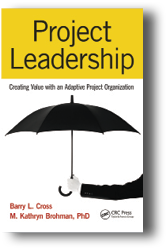 Project management is a hot topic with all sorts of self-help books appearing to help you be a better project manager. These resources range from the complex, such as the Project Management Institute’s Project Management Book of Knowledge, to simplified versions where you can manage several projects at once, such as Campbell’s The One-Page Project Manager that advocates for a one sheet of paper approach.
Project management is a hot topic with all sorts of self-help books appearing to help you be a better project manager. These resources range from the complex, such as the Project Management Institute’s Project Management Book of Knowledge, to simplified versions where you can manage several projects at once, such as Campbell’s The One-Page Project Manager that advocates for a one sheet of paper approach.
Cross and Brohman, in Project Leadership: Creating Value with an Adaptive Project Organization, take the discussion up one level arguing that many, if not most, projects fail because of poor leadership. They argue that leadership should be responsible for monitoring all projects, both formal and informal.
One thing worth noting: Both authors are academics at the Queen’s University School of Business in Australia. However, both have had experience with international companies, so their examples are not limited to Australian situations.
They quickly identify who the reader is and who the reader is not: “ . . . the tactics we discuss are intended for you and your peers in management, while not so much for the project team members” (p. xii). In nine chapters plus two appendices, they lay out their argument. They define leadership as “connecting the strategy and purpose of the firm to the key projects. . . . [It] provides oversight, visibility, control, and learning to all projects” (p. 40).
The first three chapters are fairly standard and easily recognized by those familiar with project management. For new project managers, the authors set the scene, focusing on the case for project leadership and why projects fail, centering their comments on their view that leadership is at fault for many failed projects.
The next five chapters also cover fairly standard topics: oversight and control (Chapter 5), risk management (6), scheduling (7), and operation (8). Again, the perspective is not that of one actually working on the project but of the oversight of leadership in one or many such projects.
And that brings us to Chapter 9: “Building an Adaptive Project Organization,” which is the heart of their argument. They assert that the key to effective leadership is an adaptive environment that has control, focus, and attention on oversight and visibility: “An adaptive project organization, then, needs adaptive structures, processes, and systems . . . ” (p. 160). Adaptive equates with careful reaction to surviving in changing conditions.
For those in leadership positions, Project Leadership could add to available leadership tools. The examples are from several areas in academic and business, so readers can adapt solutions to their situations. The book’s weakness is that so much of it is highly generalized and abstract, as it must be to appeal to a variety of readers. For a technical communicator looking to increase leadership skills and seeing how his or her organization’s projects often seem to fail, the book is a good first place to begin.
Tom Warren
Tom Warren is an STC Fellow, Jay R. Gould Award for Excellence recipient, and professor emeritus of English (technical writing) at Oklahoma State University, where he established the BA, MA, and PhD technical writing programs. Past president of INTECOM, he served as guest professor at the University of Paderborn, Germany.
WordPress: The Missing Manual
Matthew MacDonald. 2014. Sebastopol, CA: O’Reilly Media. [ISBN 978-1-449-34190-9. 613 pages, including index. US$29.99 (softcover).]
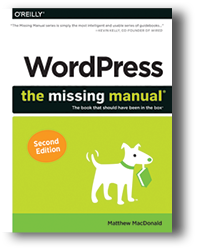 WordPress: The Missing Manual is a very useful guidebook for anyone planning to create a WordPress website, from a complete beginner to someone with Web design and WordPress experience. In my case, I knew how to hand-code a website using HTML and also had experience editing WordPress sites but needed a guide when it came to moving my website to the more convenient WordPress platform. I found it to be just what I needed to get over the hump.
WordPress: The Missing Manual is a very useful guidebook for anyone planning to create a WordPress website, from a complete beginner to someone with Web design and WordPress experience. In my case, I knew how to hand-code a website using HTML and also had experience editing WordPress sites but needed a guide when it came to moving my website to the more convenient WordPress platform. I found it to be just what I needed to get over the hump.
MacDonald begins by explaining how WordPress works and what kinds of sites can be built with it, from basic blogs to catalogs and business websites. Two main options are available for hosting WordPress sites. One is to use WordPress.com, which is free, at least initially. The other is to use another Web host of your choice, which is called the self-hosting option. MacDonald includes a helpful table on pages 20 and 21 that compares these two options. Following are two chapters with step-by-step instructions on how to proceed with each.
From there, in Chapter 4, MacDonald describes how to create posts on your new website using the WordPress interface, Dashboard. Also explained is how to organize posts using Categories and Tags. Chapter 5 covers choosing a theme and polishing it for your own needs. The following three chapters cover how to make your posts look fancier and more interesting, including how to add pictures, how to add pages and menus, and how to allow your readers to make comments. Once mastering all these skills, many readers will have a nice, basic website that they are completely satisfied with. However, this is only the first half of the book.
The next section of WordPress: The Missing Manual is “Supercharging Your Blog.” Here, the reader can learn how to use plug-ins to add new features, such as contact forms and mobile support, and also add special features such as picture galleries, video, and music. Chapters 11 and 12 cover adding other authors to your site and attracting a crowd of readers.
The final section, From Blog to Website, covers more specialized skills such as editing your theme to customize your website and building a more advanced WordPress site. Many readers will never need to use this part of the book, but more experienced Web designers will enjoy it.
Throughout WordPress: The Missing Manual, MacDonald demonstrates each step of the process for creating a WordPress site with easy-to-understand instructions and visual support. He provides many useful figures and text boxes that go into more detail on specific topics. Also included are three appendices on Migrating from WordPress.com, Securing a Self-Hosted Site, and Useful Websites. MacDonald wrote the book in such a way that readers can start at the beginning or jump to whatever topic is of interest. I highly recommend it to everyone interested in using WordPress.
Jennifer Spanier
Jennifer Spanier has been a freelance book and database indexer since 2009 and is an active member of the American Society for Indexing. Previously, she has worked as a biologist and a public librarian and indexes in a wide variety of subject areas.
The Power of Visual Storytelling: How to Use Visuals, Videos, and Social Media to Market Your Brand
Ekaterina Walter and Jessica Gioglio. 2014. New York, NY: McGraw-Hill Education. [ISBN 978-0-07-182393-7. 224 pages, including index. US$29.00 (softcover).]
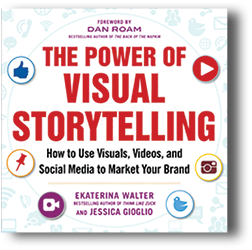 “For 32,000 years, people have drawn. We’ve written for only 5,000,” states Dan Roam (p. ix), author of The Back of the Napkin, in the Foreword to The Power of Visual Storytelling: How to Use Visuals, Videos, and Social Media to Market Your Brand. This powerful statement reminds the reader that storytelling is thousands of years old. Our ancestors told stories and drew pictures to convey and record information. The stories were then carried down from generation to generation. Written language has only come about in the last 5,000 years, and the earliest languages used pictures or symbols.
“For 32,000 years, people have drawn. We’ve written for only 5,000,” states Dan Roam (p. ix), author of The Back of the Napkin, in the Foreword to The Power of Visual Storytelling: How to Use Visuals, Videos, and Social Media to Market Your Brand. This powerful statement reminds the reader that storytelling is thousands of years old. Our ancestors told stories and drew pictures to convey and record information. The stories were then carried down from generation to generation. Written language has only come about in the last 5,000 years, and the earliest languages used pictures or symbols.
Since Johannes Gutenberg invented the printing press in 1440, there has been a surge in the printed word. It wasn’t until the 21st century ushered in mobile technology, such as Apple’s iPhone and iPad, that we have the ability to once again tell stories. These and other similar devices gave rise to social media, such as Facebook, Google+, Instagram, LinkedIn, Pinterest, Twitter, and YouTube. Consumers are turning to social media rather than books or manuals to locate information and procedures. At the same time, attention span is diminishing. So, it is important for companies to use visuals, along with text, to tell our stories and use a variety of social media to reach customers.
There is power in visuals. For example, Walter and Gioglio illustrate this by pointing out the word GIRL by itself doesn’t convey emotions, nor does it tell us what she is doing or how old she is. However, just by including an image of a girl, additional information is easily conveyed. The authors point out that visuals are processed 60,000 times faster than text.
In addition, the authors point out that “viewers are 85% more likely to purchase a product after watching a product video” (p. 21).
The Power of Visual Storytelling begins by summarizing the rise of visual storytelling, and it gives an overview of the types, tips, and tactics of visual marketing. The authors explain the power of using visual storytelling on social networks. I found Chapter 4, “Developing a Visual Storytelling Road Map: From Strategy to Implementation,” to be a tremendous resource for anyone developing a social media plan for their company. This chapter stresses the importance of auditing and analyzing what to do and walks the reader through a step-by-step process to implement visual storytelling. The book concludes with real-time marketing examples of how social media is used. Also, tips, such as the “Social Media Image Sizes by Platform” (pp. 150–151), are sprinkled throughout.
This book is an ideal reference for incorporating storytelling into your company’s marketing and social media.
Rhonda Lunemann
Rhonda Lunemann is an STC member of the Twin Cities chapter. She is a technical writer with Siemens PLM Software. Rhonda is also a member in a local writers’ group, Write Now!.
Out of the Box Thinking for Successful Managers
William F. Roth. 2014. Boca Raton, FL: CRC Press. [ISBN 978-1-4822-4706-0. 214 pages, including index. US$49.95.]
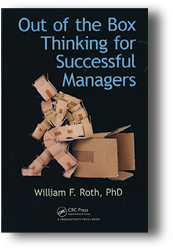 While excited to receive a copy of Out of the Box Thinking for Successful Managers, my excitement quickly turned to disappointment. This book does not deliver on the title. It has some good pieces of information, but I don’t know that you necessarily need to read this book to learn them. For example, you can read could read Daniel Pink’s Drive: The Surprising Truth About What Motivates Us to learn the same ‘out of the box thinking’ for managers, along with additional information that is unique to Pink’s book.
While excited to receive a copy of Out of the Box Thinking for Successful Managers, my excitement quickly turned to disappointment. This book does not deliver on the title. It has some good pieces of information, but I don’t know that you necessarily need to read this book to learn them. For example, you can read could read Daniel Pink’s Drive: The Surprising Truth About What Motivates Us to learn the same ‘out of the box thinking’ for managers, along with additional information that is unique to Pink’s book.
I spent some time thinking about where this book went wrong. My assessment is that Roth lacked a specific audience definition. The book is written for managers, but what type of manager? For example, the “manager” label can be applied to many roles within an organization. There are the first-line managers who provide direct support for many employees. There are the more senior managers who often manage managers. There are also directors, general managers, vice presidents, and other management roles that eventually lead to chief executive officer.
I assumed Out of the Box Thinking for Successful Managers was written for the most common management role (to appeal to the largest audience): The first-line manager. Yet the first-line manager does not usually have the authority to implement many of the recommendations for change that Roth proposes.
Domain also matters. Writing a book for managers who work in the technology or pharmaceutical sectors differs from guidance you’d provide to managers in the retail or manufacturing industry. Roth writes the book as though the guidance works across industries and that has not been my experience.
The biggest problem I have with this book is that the organizational issues that affect change from being successful are not discussed in enough detail. All the management theory and proposals for change do not work well if the organization is dysfunctional. Roth could have provided some criteria for identifying a dysfunctional organization and guidance for how to handle this scenario.
In addition, he could have provided guidance for companies of various sizes. Being a successful manager at a company with 100 employees is very different than being successful at a company with 8,000 employees. Organizational change is more challenging in various scenarios and this challenge is not addressed.
My take away is that you should skip this book and spend your time reading another book in the category. I want to love it, but it falls short.
Angela Robertson
Angela Robertson is a technical program manager in Raleigh, NC. She currently works in Customer Content Services with Red Hat Software. Prior to her current role, she worked in a variety of content-related roles with IBM Corporation. She has a master’s of science degree from North Carolina State University.
Applying Educational Research: How to Read, Do, and Use Research to Solve Problems of Practice
M. D. Gall, Joyce P. Gall, and Walter R. Borg. 2015. 7th ed. Hoboken, NJ: Pearson. [ISBN 978-0-13-286863-1. 604 pages, including index. US$92 (looseleaf).]
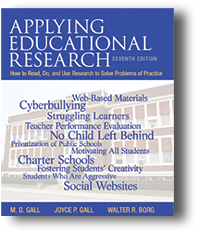 Technical communication programs recognize the importance of research related to their students’ careers. Understanding and applying research in such areas as reader analysis, accessible instructions, and graphic design, among others, enhances the quality of the products future technical communicators produce. Unfortunately, the amount of quantitative, qualitative, ethnographic, and other forms of technical communication research is minimal but growing. Besides these research projects, research in other fields can be used, as in the case with Gall, Gall, and Borg’s Applying Educational Research: How to Read, Do, and Use Research to Solve Problems of Practice.
Technical communication programs recognize the importance of research related to their students’ careers. Understanding and applying research in such areas as reader analysis, accessible instructions, and graphic design, among others, enhances the quality of the products future technical communicators produce. Unfortunately, the amount of quantitative, qualitative, ethnographic, and other forms of technical communication research is minimal but growing. Besides these research projects, research in other fields can be used, as in the case with Gall, Gall, and Borg’s Applying Educational Research: How to Read, Do, and Use Research to Solve Problems of Practice.
Much can be gained from their material. Not only are their instructions useful for a particular approach but also their use of both excerpts from research articles as well as full text examples. They divide their text into six parts and 19 chapters. Further, they provide key points, study suggestions, a self-check and suggested answers, five appendices, a glossary, and name and subject indexes. Part One provides an overview of using research (two chapters); Part Two discusses applying research (two chapters); Part Three explores quantitative research (eight chapters); Part Four looks at qualitative research (four chapters); Part Five shows how quantitative and qualitative research can be combined (one chapter); and Part Six addresses other research methodologies (two chapters).
While education students wanting to do research are the primary target of Applying Educational Research, they are not the only ones that can benefit. Frequently, trainers turn to educational research to strengthen their training programs. They can apply results in the training room as well as use them to support proposals. But, are they prepared to read, accept, and apply the results? No doubt some trainers have a background that prepares them to critically analyze the research they use. Many, however, are not so prepared, and for them, Applying Educational Research will provide a valuable resource.
Technical communicators, especially trainers, will find suggestions on how to do many types of research. For those doing research that describes a given population (users, for example), a study that uses descriptive statistics might be most valuable. Chapter 9 offers help in determining the sample size and type; constructing questionnaires, including scales such as the Likert scale; and evaluating the evidence. In addition, those who read and apply research will find the sections on evaluating different research methodologies helpful.
Will this book be valuable to technical communicators, especially given its focus and price? It would certainly prove useful to a limited population and, as such, would find a place in a company library. The book, being in a 7th edition, means that academia accepts it, but what about outside academia? I think it would be especially useful for trainers and technical communicators who do research on information design and their anticipated audience.
Tom Warren
Tom Warren is an STC Fellow, Jay R. Gould Award for Excellence recipient, and professor emeritus of English (technical writing) at Oklahoma State University, where he established the BA, MA, and PhD technical writing programs. Past president of INTECOM, he served as guest professor at the University of Paderborn, Germany.
Intelligent Content: A Primer
Ann Rockley, Charles Cooper, and Scott Abel. 2015. Laguna Hills, CA: XML Press. [ISBN 978-1-937434-46-5. 128 pages, including index. US$24.95 (softcover).]
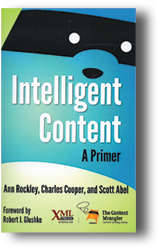 Intelligent Content: A Primer by Rockley, Cooper, and Abel starts with an insightful definition for intelligent content that engages the reader and sets the pace for broader concepts that follow. They use call outs, notes, and highlighted practical advice to distinguish benefits and concepts that educate and make content issues easier to grasp.
Intelligent Content: A Primer by Rockley, Cooper, and Abel starts with an insightful definition for intelligent content that engages the reader and sets the pace for broader concepts that follow. They use call outs, notes, and highlighted practical advice to distinguish benefits and concepts that educate and make content issues easier to grasp.
The authors argue that organizations need to consider a more strategic approach in finding solutions to the content conundrum. Rockley, Cooper, and Abel support their argument with research, business intelligent data, real-world scenarios, and ideas that take a leap into a world where content moves from “productivity-zapping” mode to quality content experiences. Through anecdotal case studies, they drive the point that intelligent content is the revolutionary way to reach sustainable business solutions.
Professional writers and those creating or managing content would find Chapter 4, The Benefits of Intelligent Content, an information reservoir to shift the needle from siloed thinking and practices. This chapter heightens the practical and business-sense argument: that intelligent content helps organizations achieve positive bottom-line impact derived from changing consumer needs and expectations that are satisfied. The fact that intelligent content helps to outpace a competitor makes its use and application logical, sensible, and sound in judgment; rework is avoided, making processes supportive of LEAN concepts.
Rockley, Cooper, and Abel explain how broadly applicable intelligent content is, not only in content marketing, but in other common places: traditional marketing content, product and support content, learning and training content, and employee-focused content. They write in simplistic terms that make the reader want to progress through the chapters learning more with a curiosity to know how the authors will further discuss these concepts.
The authors offer a peak into the futuristic state of intelligent content by briefing the reader on the “Internet of Things.” They share research on the future state of connectedness and summarize four decades of content development and presentation in a manner that vividly tells the story for change in the status quo. Rockley, Cooper, and Abel also align their concepts with Web Content Accessibility Guidelines (WCAG) that encompass users with disabilities.
Intelligent Content comes full circle with guided steps on Transitioning to Intelligent Content, and finally Getting Started with Intelligent Content. The authors, in these final two chapters, offer practical advice on dealing with key related elements including culture change. They include a checklist to assist in developing an intelligent content strategy that is intuitive and adds a component that takes the audience from acquiring knowledge to moving to the functional. The glossary of terms is a useful quick reference.
This subject has not yet been exhausted nor is it sufficiently discussed in organizations. Employees are programmed to think they must save or create everything in a standard format. The Content Wrangler’s “Content Strategy Series” should consider including a book in the series on the use of intelligent content in mitigating legal nightmares that might potentially arise during discovery.
Caroline Bruno
Caroline is an STC student member. She handles corporate communications for C-suite executives at a Fortune 50 company in New York. Caroline has a careful eye for editorial detail in text and visual content with a honed eye for audience, context, and purpose issues.
Infographic Designers’ Sketchbooks
Steven Heller and Rick Landers. 2014. New York, NY: Princeton Architectural Press. [ISBN 978-1-61689-286-9. 352 pages, including index. US$60.00.]
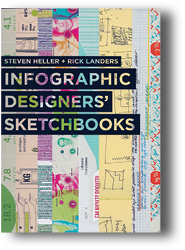 Infographics are now widely available in many capacities, with magazines and news sources in online or print as some of the major communication purveyors. Data visualizations, information design, or information graphics (infographics for short) are on the rise in the information age and, as a result, we are seeing a surge in this type of publication design. Steven Heller’s and Rick Landers’s Infographic Designers’ Sketchbooks is a collection of sketches from designers of data in various forms.
Infographics are now widely available in many capacities, with magazines and news sources in online or print as some of the major communication purveyors. Data visualizations, information design, or information graphics (infographics for short) are on the rise in the information age and, as a result, we are seeing a surge in this type of publication design. Steven Heller’s and Rick Landers’s Infographic Designers’ Sketchbooks is a collection of sketches from designers of data in various forms.
The book contains examples of sketches and final projects from 73 designers. The work comes from designers and teams, those who have been entrenched in the designing of infographics for years, those who have made a name for themselves, those who have successfully dabbled in the field, and those who are primarily masters in fine arts candidates. At least 11 contributors have ties specifically to Heller’s School of Visual Arts. It would be interesting to know the selection process the authors used in determining what work samples to include.
Some designers express their love of working traditionally with pen and pencil, while others claim that data visualization requires precision that is only achievable through the computer and therefore sketching by hand is a waste of time. Despite this, they all feel sketching is necessary; none of the designers achieved the end solution out of the gate; and all required some fine tuning and editing.
Infographic Designers’ Sketchbooks is a great source of inspiration for anyone interested in data visualization, whether merely an admirer or interested in learning or developing this as a skill set. The book is a quick read, since it primarily consists of a collection of images in the form of sketches alongside final infographic designs. It does, however, include a brief narrative for every contributor that provides a great deal of insight into processes, philosophies, and theories on the designs. Despite the book’s brevity, anyone with an interest in information design or beautiful graphics could spend hours poring over the images.
Advancements in technology and the Internet’s proliferation have made data king, what is often described as “Data Glut”; according to Hymei Song “Raw Data has no value in itself . . . only extracted information has value” (p. 294). The solution to this problem seems to be in the form of infographics with the intent being to relate information from raw data in an understandable form to the viewer. We will likely continue to see a rise in the use and interest of information graphics so sources such as Infographic Designers’ Sketchbooks will continue to serve those in the various communication fields.
Amanda Horton
Amanda Horton holds an MFA in design and currently teaches graduate and undergraduate courses at the University of Central Oklahoma in the areas of design technology, design studio, and history of graphic design. She serves as a book reviewer for Technical Communication.
Digital Cosmopolitans: Why We Think the Internet Connects Us, Why It Doesn’t, and How to Rewire It
Ethan Zuckerman. 2015. New York, NY: W. W. Norton & Company. [ISBN 978-0-393-35032-6. 312 pages, including index. US$15.95 (soft cover).]
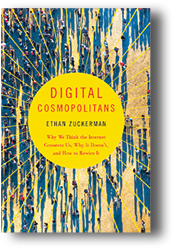 “Thanks to new tools, speech need no longer be controlled by those who own the means of publishing and distribution, or by governments that would restrict thought and communication,” (p. 121) states a 2004 manifesto that inspired the creation of Global Voices, an organization co-founded by Zuckerman that makes international stories overlooked by the mainstream media accessible to a wider public. In this book, he argues that while social media and the Internet let people learn about countries and events they wouldn’t know about otherwise, these same tools often limit their exposure to information beyond a narrow sphere of interest even more than, say, a major newspaper would. It’s not that the information isn’t out there—albeit not necessarily in a language we understand—it’s that we don’t usually seek it out.
“Thanks to new tools, speech need no longer be controlled by those who own the means of publishing and distribution, or by governments that would restrict thought and communication,” (p. 121) states a 2004 manifesto that inspired the creation of Global Voices, an organization co-founded by Zuckerman that makes international stories overlooked by the mainstream media accessible to a wider public. In this book, he argues that while social media and the Internet let people learn about countries and events they wouldn’t know about otherwise, these same tools often limit their exposure to information beyond a narrow sphere of interest even more than, say, a major newspaper would. It’s not that the information isn’t out there—albeit not necessarily in a language we understand—it’s that we don’t usually seek it out.
Digital Cosmopolitans: Why We Think the Internet Connects Us, Why It Doesn’t, and How to Rewire It documents that stance using Zuckerman’s own experience with Global Voices, research by various scholars, activists’ reports, and background information. It is a compellingly written account of why many people are now exposed to an even narrower slice of world events than they used to be and what can be done to change that situation. Zuckerman also explains why expanding our horizon in terms of international information will become ever more important in the future. He introduces the concept of “bridge figures” who provide specialized knowledge about a location to people elsewhere on the globe. Modern migration patterns are producing an increasing number of people capable of becoming bridges between their new homes and the countries they left behind.
Then, of course, there is the question of language. Google Translate and other machine translation tools can provide us with the basic gist of an article in a foreign language, but they can’t accurately convey all information in the article, let alone subtle phrasing that may be important for understanding the writer’s view of the events. A bridge figure is therefore also important as a translator, not just an explainer. That’s why professional translators make excellent bridge figures: they are by definition bilingual (or trilingual) and either come from another country or have lived there for an extended period. Who better to explain current events in Haiti to an American than someone who grew up there but now lives in the US and regularly translates information from Haiti for a US audience?
However, to harness the potential of such bridge figures, people must first access the information they can provide. One way to do so is to engineer serendipity online—to build tools that provide blog posts, news, etc. from around the globe related to a user’s general interests in a language the user understands. We are not there yet, but as Zuckerman concludes: “If we want a world that values diversity of perspective over the certainty of singular belief, a world where many voices balance a privileged few, where many points of view complicate issues and push us toward novel solutions, we need to build that world” (p. 272).
Barbara Jungwirth
After writing software documentation and managing an IT department, Barbara Jungwirth now translates German technical documents into polished English appropriate for a specific audience. She owns reliable translations llc (www.reliable-translations.com), writes a blog called On Language and Translation (www.reliable-translations.com/blog/), and tweets (@reliabletran). You can also connect with her on LinkedIn (www.linkedin.com/in/BarbaraJungwirth).
Teaching and Learning with Technology
Judy Lever-Duffy and Jean McDonald. 2014. 5th ed. Upper Saddle River, NJ: Pearson. [ISBN 978-0-13-381426-2. 368 pages, including index. US$74.00 (looseleaf).]
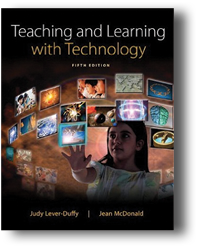 As technology continues to change along with the evolving educational system it serves, textbooks such as Lever-Duffy’s and McDonald’s Teaching and Learning with Technology become more relevant as required reading material for teachers in all subject areas. Overall, this twelve-chapter textbook describes the changing needs to be served by new technology, methods of evaluating and selecting technology in different situations, implementation and design of such technology, and the emerging technologies to meet the future educational needs.
As technology continues to change along with the evolving educational system it serves, textbooks such as Lever-Duffy’s and McDonald’s Teaching and Learning with Technology become more relevant as required reading material for teachers in all subject areas. Overall, this twelve-chapter textbook describes the changing needs to be served by new technology, methods of evaluating and selecting technology in different situations, implementation and design of such technology, and the emerging technologies to meet the future educational needs.
The book opens with chapters on standards by which to measure technology preparedness in education as well as available certifications and licensures. The authors break down the types of classroom technologies by administrative, presentations, lesson preparation, and communications. The text also makes use of text boxes with anecdotal and situational stories from real classroom experiences, “Tech Tutor” video excerpts from the publisher’s website for later watching, and a very detailed glossary for looking up unfamiliar terms introduced.
Chapters two through four cover integrating technology with learning styles, designing instruction around technology, and applying technology for special needs. Chapter five discusses classroom computers from hardware and mouse technology to networking, printers, and data storage. For example, cloud computing has drastically changed available access of educational materials. By chapter six, the text focuses on specific types of classroom technology such as mobile devices, wireless services, video conferencing, and e-book readers.
Chapter seven outlines software tools for educators using a table to list applications for each database feature. These types of tables are present throughout the text and clearly lay out detailed information. The distance learning table in chapter ten is one exception to the usual clarity, as it is confusing in attempting to show course completion and success rates. The large amount of information in the table would be easier to read and digest if it were larger.
The final chapter, and my favorite, was a glimpse of the Jetsons in textbook form. In this chapter, Lever-Duffy and McDonald describe in detail the projected technologies of the future. Most interesting to me was electronic paper, a digital solution to paper handouts. For the cost of around $100 per page of electronic paper, students can download class handouts onto a rollable, foldable device. This could, feasibly, even eliminate the need for a recycle bin in classrooms of the future!
Lever-Duffy and McDonald sum up the value of learning from the text with this: “Teaching in the 21st century will include new pedagogy that uses new technologies. Flipped classrooms and personal learning environments are just the beginning. Creative teachers will develop yet-to-be imagined models for instructional delivery and new ways to use current and emerging technologies. With this change for educators of the 21st century, familiarity and training in new technology are just the beginning of their journey as tech-savvy educators” (p. 297).
Julie Kinyoun
Julie Kinyoun is an on-call community college chemistry instructor in Southern California. As an avid reader, she enjoys reviewing books that can help her and others become better teachers.
Training Design Basics
Saul Carliner. 2015. 2nd ed. Alexandria, VA: ATD Press. [ISBN 978-1-56286-925-0. 220 pages. US$29.95 (softcover).]
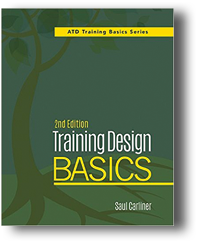 What do you do if you’re a technical writer or editor suddenly assigned to training? What about if you are interested in a career change, perhaps involving some travel, and training appeals to you? Or maybe you’re a student in a technical communication program looking for your niche. In all these cases, Training Design Basics might be the place to start.
What do you do if you’re a technical writer or editor suddenly assigned to training? What about if you are interested in a career change, perhaps involving some travel, and training appeals to you? Or maybe you’re a student in a technical communication program looking for your niche. In all these cases, Training Design Basics might be the place to start.
This book won’t make you a training expert, but you will learn something about the aspects of training from contracts, scheduling, and goal setting to curriculum design, testing, and assessment. You may want to read assertively because the information may not all be relevant. For example, you may want to skip the early chapters on project estimation and contract language if you plan to work within a corporation’s training group. (Your manager will likely handle these jobs.)
Skip to Chapters 5–7 to get the most information because these chapters cover organization, delivery strategies (in person vs computer based, for example), and materials. Chapter 8 covers writing (use “a supportive tone”) and producing documents (fonts, page layout, slide design), which more experienced readers can skim or skip.
Technical communication or UX instructors may like Chapter 9, which covers assessment of the training program and materials. However, don’t expect a detailed (or theoretical) approach; the material here is more appropriate for students who are learning such tasks. As the publisher says, the Training Basics series “takes a minimalist approach to your learning curve dilemma,” (p. v), and that’s what this book does best.
Training Design Basics contains notes, sidebars, “Basic Rules,” and tables of information. Some chapters contain exercises for practicing the techniques, although most readers will skip these and simply apply the techniques on real training projects. Carliner may want to review the entire text through the eyes of a reader who has their own project and revise accordingly.
Additionally, in places, the language needs flexibility. For example, “the back matter for a self-study training program includes six items” (p. 95) should allow for differing approaches. Sometimes, usually, often includes? These types of absolutes, rather than seeming authoritative, come across as restrictive and inflexible.
The biggest oversight with this book? No index. Yes, the text is meant to be read linearly—the first time—but after that, using the text as a reference will be frustrating. Furthermore, Carliner has included a formal reference list and a list of additional references for each chapter, but these are likely to be overlooked. The Table of Contents is sparse and repetitive. Every chapter begins with “The Basics of,” and most chapters end with the exact same headings (one on types of project, another “Getting It Done”). Any third edition should address these issues.
Despite these flaws, Training Design Basics does what it promises: You’ll get the basics of training.
Kelly A. Harrison
Kelly A. Harrison, MFA, works as a consultant, speaker, and writing instructor in San José, CA. For over 20 years, she has written print and online content for various high-tech computer companies. Currently, she teaches writing at San José State University and Stanford University.
Landmark Essays on Speech and Writing
Peter Elbow, ed. 2015. New York, NY: Routledge. [ISBN: 978-0-415-64169-2. 312 pages, including index. US$60.00 (soft cover).]
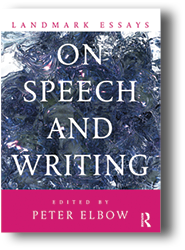 Landmark Essays on Speech and Writing discusses the obvious, hidden relationships between speech and writing. Punctuation is the best way to capture the sound and rhythm of spoken language, yet punctuation doesn’t capture everything. Other features like italics, boldface, and word order are contributors. Still, punctuation is the most important tool with its main function of dividing chunks of meaning to make reading easier. Reading aloud can help decide the best way to punctuate, using a tape recorder, for example. Yet, a tape recording of someone reading aloud is seldom mistaken for speech: “We know written material when we hear it” (p. 209).
Landmark Essays on Speech and Writing discusses the obvious, hidden relationships between speech and writing. Punctuation is the best way to capture the sound and rhythm of spoken language, yet punctuation doesn’t capture everything. Other features like italics, boldface, and word order are contributors. Still, punctuation is the most important tool with its main function of dividing chunks of meaning to make reading easier. Reading aloud can help decide the best way to punctuate, using a tape recorder, for example. Yet, a tape recording of someone reading aloud is seldom mistaken for speech: “We know written material when we hear it” (p. 209).
Oral culture was the universal medium for thousands of years before the rise and growing influence of print. And with oral culture came the need for building features into language that helped people to better remember things like rhyme, idioms, well-known phrases, and collocations.
Landmark Essays on Speech and Writing highlights some of the fascinating differences between the two modes: Not everyone learns to write, but nearly everyone learns to speak. Speech is for the ear, writing for the eye. Speaking is done with the mouth, writing with the fingers. Speaking exists in time (we speak and it’s gone), writing in space (it can be recalled and reexamined endlessly). Speaking tends to be spontaneous; writing tends to be planned. Speaking tends to be more informal, writing, more formal (“tends” to be is crucial here). This book examines these differences and more at great depth.
The essay authors explore the relationship between art and writing, pointing out that art—visual meanings scraped on cave walls—preceded writing by some 25,000 years. And it is not until 3500 BC that we get the “rebus:” combining pictures to make sounds, such as a bee plus a leaf to get the word “belief.” A giant step toward writing that took almost 20,000 years! The images have disappeared from our abstract alphabet: “But the pictures once were there” (p. 9).
Fashions play their part. Early 20th century linguists stressed the primacy of speech over writing. In the 60s and 70s, several scholars suggested that the two modes are fundamentally different: that writing is more explicit. Others, that writing is more structurally complex with longer sentences and more subordination.
The most useful distinction for us: conversation is typically personal rather than informational. So many lexical and syntactic differences flow from this distinction. The article then presents a long list of contrasts between the two. For example: In conversation, roughly 70% of verbs are in the present tense, the progressive is three times as common, and modal verbs (can, will, could) twice as common.
Such a list can be useful for those who feel a conversational tone is more effective in any kind of writing.
Steven Darian
Steven Darian is an STC Fellow, having retired from teaching business and technical writing at Rutgers for 33 years and in eight countries. He was a manager for Raytheon in Saudi Arabia. Steven’s next book is “Tools of the Trade: Technique in Nonfiction, 2015.”
Information Age: Six Networks that Changed the World
Tilly Blyth, ed. 2014. London, England: Scala Arts Publishers Inc. [ISBN: 978-1-85759-901-5. 224 pages, including index. US$55.00.]
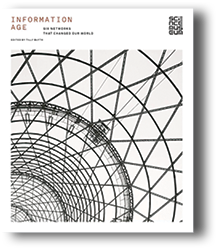 We live in an age of so many technological wonders that we tend to forget, especially if young, that the world’s information—real-time news from distant lands, clips from old movies, our exact location on the face of the earth, the ability to communicate with both friends and strangers 24/7—was not always available at the swipe of a finger.
We live in an age of so many technological wonders that we tend to forget, especially if young, that the world’s information—real-time news from distant lands, clips from old movies, our exact location on the face of the earth, the ability to communicate with both friends and strangers 24/7—was not always available at the swipe of a finger.
For those who want a better understanding of how our modern networked world developed over the past two centuries, Information Age: Six Networks that Changed the World is full of riches.
In a handsome “coffee-table” format, it tells the stories of the inventors, entrepreneurs, and early adopters who made the modern world possible. Put together by the Science Museum in London to showcase its impressive collection of artifacts related to the history of information technology, the book uses beautiful photographs and archival material to trace the history of six networks:
The hard wiring of the earth, starting with the trans-Atlantic cable, which allowed rapid wired communication across oceans and between distant locations.
The development of broadcasting, which allowed real-time dissemination of news and entertainment via radio and television.
The development of the telephone exchange, which allowed real-time, person-to-person communication to be shared over a finite infrastructure.
The development of satellite communication, which greatly enhanced earlier technologies by freeing them from the need for trunk lines and transmission towers and enabled new technologies such as GPS.
The development of the Internet, which linked computers, enabled email, enabled instantaneous access to vast quantities of stored information, and revolutionized commerce.
The development of cell tower technology, which allowed mobile devices to stay connected while roaming freely.
For these networks to come together and change into their present form, many pieces had to fall into place—the telegraph key, Morris code, the carbon (telephone) microphone, the vacuum tube, and hundreds of others. Many developments had humble beginnings: The first computer mouse was carved out of a block of wood. The book describes and pictures many of these developments.
Information Age is also full of interesting stories: how the idea to first deploy computers for routine business tasks came to a forward thinking head of a British catering chain and the key role played by GPS technology—then just coming online—in the Gulf War, literally guiding troops through the blinding dust of desert storms.
Given its source, the book is written from a British perspective, which provides a refreshing reminder that technology is not just the province of the US or Silicon Valley.
Besides the main text, Information Age contains essays by James Gleick, David Attenborough, and others focused on how each development stage touched the lives of ordinary people.
For anyone wanting to explore the subject through both words and pictures, this a handsome and valuable book.
Patrick Lufkin
Patrick Lufkin is an STC Associate Fellow with experience in computer documentation, newsletter production, and public relations. He reads widely in science, history, and current affairs, as well as on writing and editing. He chairs the Gordon Scholarship for technical communication and co-chairs the Northern California technical communication competition.

